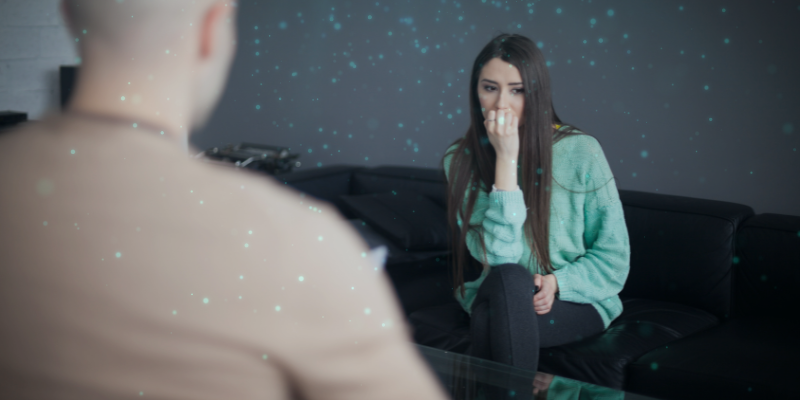
Western culture is facing a crisis affecting a wide swath of its population. Due to the COVID-19 pandemic, we’ve seen an increase in loneliness, anxiety, depression, post-traumatic stress disorder (PTSD), substance use disorder, and a broad range of other mental and behavioral disorders, including domestic violence and child abuse. At the height of the pandemic, one-quarter of all 18- to 24-year-olds said they’d “seriously considered” suicide in the last month.
In The Suicide Solution, which is being released Sept. 14, 2021, during National Suicide Prevention Month, authors Daniel Emina, MD, (Amen Clinics psychiatrist) and Rick Lawrence (award-winning author and minister) explore how conventional approaches to this crisis are falling short. In this excerpt from the book, the authors reveal how false narratives are contributing to the problem, and they offer a glimpse at a better path out of the valley of the shadow of death.
***
The wave of emotional distress has prompted a spike in mental health diagnoses and the meteoric growth of the self-help industry. Unfortunately, the common solutions offered to those beset by anxiety, depression, and “suicidality” are often shallow—they lack both efficacy and real hope, and they perpetuate an internal focus that isolates and builds on false narratives.
The common thread among those who are scrambling to avoid slipping even deeper into suicidal ideation (perpetual thoughts about planning your own death) is their inability to overcome stuck patterns of destructive thinking. Conventional approaches to dealing with this crisis often have a “surface” feel—pay attention to your mood swings and behavioral changes, then seek counseling or pharmaceuticals when you see warning signs. These are reactive, not roots, not just its fruits. “Destructive narratives” that become embedded in our internal “story” keep us stuck in this slow-moving avalanche of hopelessness.
The Hardware and Software of Suicide
A computer’s hardware is made up of the tangible and physical components that are necessary for storing and running software. Hardware serves as a delivery system for the set of instructions, or “code,” the software provides. Software is intangible—a collection of programs or instructions that enables users to interact with the hardware to accomplish specific tasks. Both work to determine the functional capabilities of a computer system.
In human beings, our “hardware” is our biology (specifically, our brain), and our “software” is our thought process or psychology. Together, they guide how we experience and interact with our world, in predictable and adaptive ways. And together, our hardware/software identity forms our experiences, capabilities, limitations, susceptibilities, and possibilities. Suicide is generally the culmination of a malfunction or failure of the brain’s hardware (biology) and software (psychology) which are hard-wired to support self- preservation. This is the result of a “multi-system failure” that coincides with what seem to be insurmountable stressors.
When Your Story Keeps You Stuck in Suicidal Thoughts
Another way to understand the human operating system (software) is to think of it as our “story.” Story works to construct, give meaning to, and set boundaries around our experience of reality. Our story is the “narrative code” that unlocks the meaning behind our experiences in life. The story we tell ourselves, about ourselves, determines how we function and influences our limitations and possibilities in life. Dan McAdams, a professor of psychology at Northwestern University, calls this our “narrative identity”—it’s our own personal mythology, complete with plot twists, thematic threads, and heroes and villains.
Our story is the “narrative code” that unlocks the meaning behind our experiences in life. The story we tell ourselves, about ourselves, determines how we function and influences our limitations and possibilities in life. Click To TweetMcAdams says we tell ourselves two basic self-narratives: 1) Redemptive Stories, and 2) Contamination Stories. The first kind of story is transplanted from the Kingdom of God, where redemption is not only the mission of the Messiah but the heartbeat of life. The second kind of story is exported and propagated by the Kingdom of Darkness, where “killing, stealing, and destroying” (John 10:10) is the mission.
The “bugs” (or viruses) in our story are destructive narratives that operate, often undetected, in the background of our emotional/spiritual/psychological operating system— distortions that cause us to perceive reality, and our own story, inaccurately. Vulnerabilities to these bugs are sometimes pre-determined by our “hardware”—the biology we inherit through genetics or that are written into our code by our experiences, upbringing, or choices (which introduce viruses or buggy software). When bugs go undetected or unchallenged, they grow into contamination stories, sometimes so subtly that we can no longer separate our true identity from the corrupted version the contaminants have produced.
Some of us never overcome our bugs—and when that happens, we are susceptible to recurrent bouts with mental illness, or we can inadvertently infect others with our way of thinking. Many of us—really most of us, according to the National Institutes of Health—go through seasons when we are stuck so deeply in our ruts that the walls closing in on us make it seem as though we are at the bottom of the Grand Canyon.
3 Steps on the Journey Out of the Darkness
Along the path out of the valley, there are mileposts:
1. Understand the multiple contributors to how we feel and behave.
Our genetics, life experiences, unique temperaments and personalities, brain injuries, chronic health challenges, infections, and toxin exposures are stacked stressors that generate brain illness. Hardware that is compromised, and software that is corrupted, have an inexorable dragging impact.
2. Know who you are—your strengths, goals, and passions.
Our giftings come pre-packaged with vulnerabilities (for example, analytical, empathetic, and creative people all have distinct “soft spots” that come into play when the person is exposed to trauma or repeated life stressors that can’t be controlled, explained or resolved). Our vulnerabilities are charged with emotional impact. They can be further complicated by a lack of quality community connections or an unhealthy interior narrative.
3. Maintain your hardware and software, using routine debugging or “virus protection” practices.
This means living a lifestyle that continually refreshes your story, maintains an open invitation to the “co-authoring” presence of Jesus, nurtures a healthy thought life that matches your values, and pursues a healthy nutritional and exercises lifestyle. Maintenance also involves nurturing your creativity, your healthy relational connections, contributing to your community, and having an intentional approach to life.
The Suicide Solution by Daniel Emina, MD, and Rick Lawrence offers hope and a practical toolbox for people who are struggling to find their way out of a cave of anxiety, depression, and suicidal thoughts—and for anyone who cares for someone who’s been lost in that cave. Informed by the clinical realities of anxiety, depression, and suicide, the authors draw from the transformational relational strategies of Jesus to chart a path into life and freedom.





Thanks for writing this.
Comment by Cliff — September 7, 2021 @ 12:35 PM
Thank you for this blog. Great information I certainly shared.
Comment by Lori Esarey — September 10, 2021 @ 4:10 AM
Is there telephone counseling through Amenclinic
To help me erase old negative voices and heal my thoughts, mind and experience joy?
Comment by J Kearney — September 10, 2021 @ 4:25 AM
Excellentttttttttttttttttttttttttttttttttttt , sober remark
Comment by frank — September 10, 2021 @ 4:39 AM
So helpful. Thank you.
Comment by Staci — September 10, 2021 @ 4:41 AM
Amen! As in truly.
Comment by Zoe — September 10, 2021 @ 5:10 AM
Yes! Yes! Yes! Thank you for referencing such an incredible book.
Comment by JENNIFER — September 10, 2021 @ 5:49 AM
I’m so impressed with this article and will be getting multiple copies of the book. My daughter has succumbed to this plight. She’s allowed her story to be rewritten with untruths. Thank you for sending this email out.
I see hope.
Comment by Rose douglas — September 10, 2021 @ 6:36 AM
Most helpful piece put out.
Comment by Paula Kavanaugh — September 10, 2021 @ 7:04 AM
I appreciate the comparison of computer hardware and software to the brain and our thoughts. I disagree with coauthoring my life with Jesus. I am a Christian so that may seem strange. I believe in co-authoring my life with God. Jesus made God visible to humans so we could learn from him but I believe God is the author. I also believe that people who do not believe in God or Jesus are capable of creating their best selves. I wonder if your analogy distances many because of your narrow vision.
Comment by Karen McNichol — September 10, 2021 @ 7:21 AM
What about people who are not religious such as agnostic or atheist?
Comment by MJ — September 10, 2021 @ 7:52 AM
Thank you for adding Jesus to the equation. He is our true hope and lover of our souls. Thank you also for practical hands on helps to overcome the darkness.
Comment by Kay — September 10, 2021 @ 7:54 AM
Hello J Kearney, thank you for reaching out. If you have concerns about COVID-19, or if you simply want the convenience of staying at home, we are offering Telehealth and Video Therapy options. For more information about Telehealth: https://amenclinics.com/services/telehealth-and-video-therapy/.
Comment by Amen Clinics — September 10, 2021 @ 8:57 AM
Of all the advice given in this article, nutrition was the one thing that stopped & reversed my decline. My wife and I made a complete transition from the standard American diet to the Omni Diet to address physical symptoms, such as weight gain, joint pain, etc. For reasons I have yet to identify, this change eradicated the depression that plagued me all my life. Please take the best nutritional advice available seriously! The rest of the advice in this article is excellent, but largely ineffective without proper nutrition. A comprehensive, systematic approach is essential.
Comment by Fred Hubler — September 10, 2021 @ 6:00 PM
The article has is full of wisdom and insight with helpful analogy. Thank you for putting out this information.
Comment by rory kassner — September 10, 2021 @ 6:31 PM
Very informative and interesting. Thank you.
Comment by Audrey Logan — September 10, 2021 @ 7:42 PM
What a brilliant article
Thank you
Comment by Gloudina — September 10, 2021 @ 10:06 PM
You are so right… only when we see ourselves the way God does… through our ultimate redemption and transformation of our minds through the Holy Spirit is there true healing. Thank you for acknowledging this truth.
Comment by Donna Castro — September 11, 2021 @ 6:44 AM
Thank you!
Comment by Chase — September 11, 2021 @ 10:14 AM
Thanks for a great article.
Comment by Timothy Lee — September 12, 2021 @ 8:11 AM
Excellent article making sense of our inner personal narratives. It appears much of our youth is growing up with a lack of good software programmimg to detect the bugs, and how to defrag the bad/”contamination” storyline. I love this analogy, and it explains a lot.
Comment by Katie Dale — September 14, 2021 @ 10:58 AM
I love these recomendations for changing the negatives in our lives and reprograming old tapes that hold us back from living to our full potential!
Combine this w/ deep breathing meditation and the results are amazing!!
Thanks so much! This should be taught in K-12 instead of CRT and anything that demeans our kids!
Comment by Barbara Wenders — September 20, 2021 @ 10:36 PM